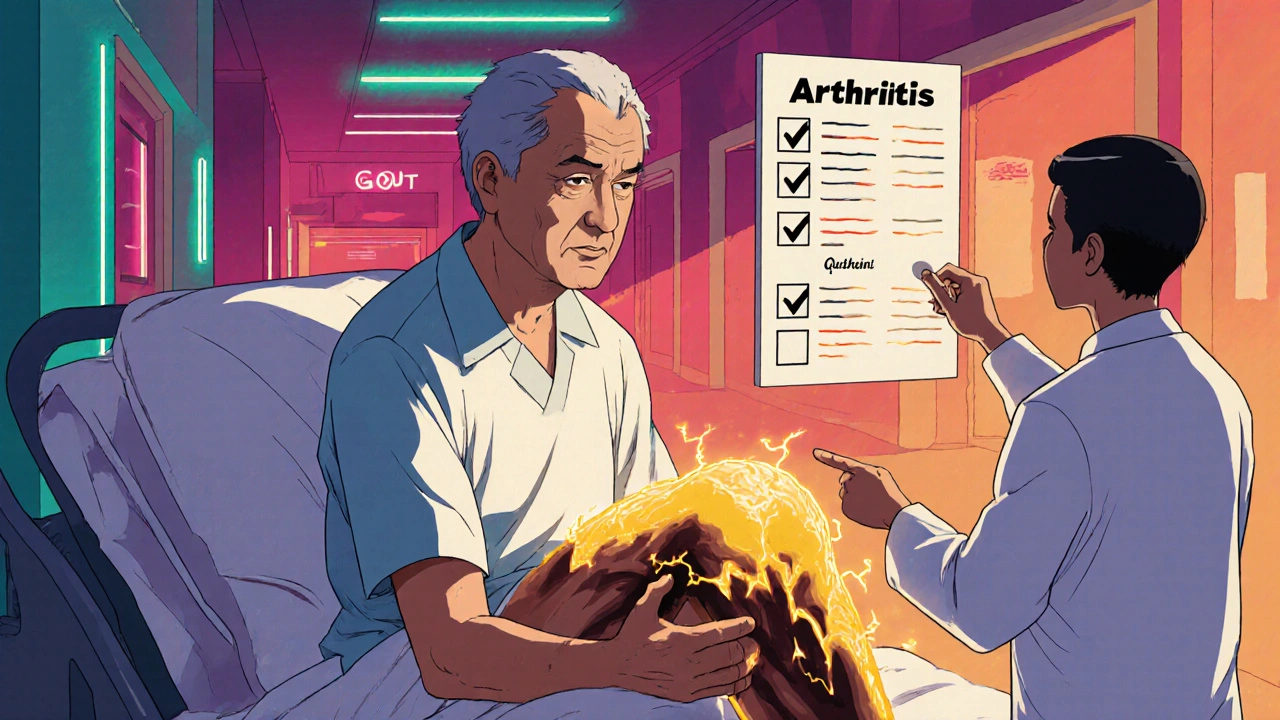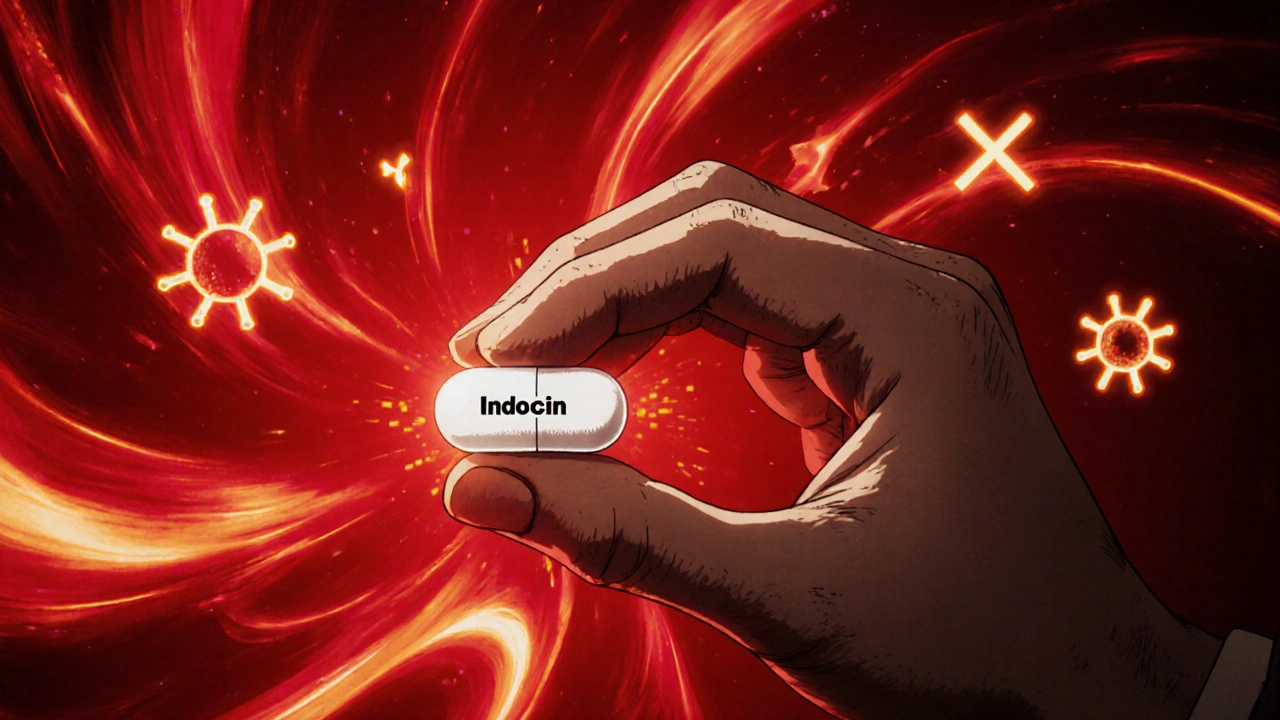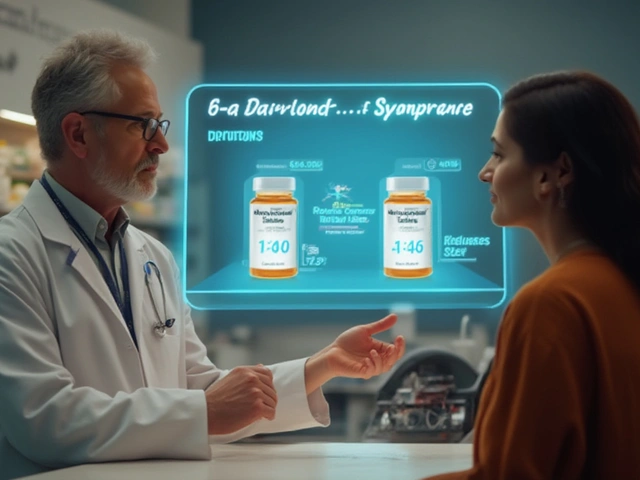Indocin is not just another pain pill. It’s a powerful prescription drug that stops inflammation at its source - not just masking pain, but calming the body’s overactive immune response. If you’ve been told to try Indocin for arthritis, gout, or tendonitis, you’re probably wondering: how does this actually work? Is it safe? Are there better options? This isn’t a drug you take lightly. It’s strong. And knowing exactly what it does - and doesn’t do - can make all the difference.
What Indocin Actually Is
Indocin is the brand name for indomethacin, a nonsteroidal anti-inflammatory drug (NSAID) first approved by the FDA in 1965. It belongs to the same family as ibuprofen and naproxen, but it’s significantly more potent. While over-the-counter NSAIDs are designed for mild, short-term relief, Indocin is prescribed for moderate to severe inflammation that doesn’t respond to weaker options.
It works by blocking enzymes called COX-1 and COX-2, which your body uses to make prostaglandins - chemicals that cause swelling, pain, and fever. By reducing these, Indocin doesn’t just numb the pain; it cuts down the root cause. That’s why it’s often used for conditions like acute gout attacks, where inflammation flares up violently.
Indocin comes in capsules, suppositories, and extended-release tablets. The standard dose for arthritis is 25 mg two or three times a day, but doctors sometimes start lower, especially for older adults. The maximum daily dose is usually 200 mg, but few people need that much. Most find relief between 75 mg and 150 mg per day.
Who Takes Indocin and Why
Indocin isn’t for everyday headaches. It’s reserved for specific inflammatory conditions:
- Arthritis: Especially rheumatoid arthritis and osteoarthritis when joint swelling and stiffness are severe. Many patients report noticeable improvement within 48 hours.
- Gout: One of the most effective treatments for sudden, painful gout flares. It often works faster than colchicine.
- Tendonitis and bursitis: When inflammation in tendons or fluid-filled sacs around joints doesn’t improve with rest or physical therapy.
- Patent ductus arteriosus (PDA) in premature infants: A rare but critical use - Indocin helps close a blood vessel in newborns’ hearts that should have closed at birth.
- Chronic pain syndromes: Sometimes used off-label for conditions like ankylosing spondylitis or certain types of back pain.
It’s not used for migraines, colds, or minor sprains. If your doctor prescribes Indocin, it’s because they’ve ruled out simpler treatments and believe the inflammation is significant enough to warrant a stronger drug.
How Indocin Compares to Other NSAIDs
Not all NSAIDs are created equal. Here’s how Indocin stacks up against common alternatives:
| Drug | Strength | Onset of Action | Typical Daily Dose | GI Risk | Used for Gout? |
|---|---|---|---|---|---|
| Indocin (indomethacin) | High | 1-2 hours | 75-150 mg | High | Yes |
| Naproxen (Aleve, Naprosyn) | Moderate | 1-2 hours | 500-1000 mg | Moderate | Yes |
| Ibuprofen (Advil, Motrin) | Low to moderate | 30-60 minutes | 1200-3200 mg | Low to moderate | Occasionally |
| Celecoxib (Celebrex) | Moderate | 1-2 hours | 100-200 mg | Lower | No |
Indocin is stronger than ibuprofen and often faster than naproxen in treating acute gout. But it also carries a higher risk of stomach ulcers and bleeding. Celecoxib is easier on the stomach but doesn’t work for gout - so it’s not a direct substitute.

Side Effects You Can’t Ignore
Indocin isn’t gentle. About 1 in 5 people experience side effects, and some can be serious.
- Stomach issues: Nausea, heartburn, ulcers, and internal bleeding are common. Taking it with food helps, but doesn’t eliminate the risk.
- High blood pressure: It can raise blood pressure in people who already have hypertension.
- Kidney problems: Reduces blood flow to kidneys. Risk increases if you’re dehydrated, on diuretics, or over 65.
- Dizziness and headaches: Especially when starting the drug. Don’t drive or operate heavy machinery until you know how it affects you.
- Rare but dangerous: Liver damage, severe skin reactions, heart failure, and allergic reactions (like swelling of the face or throat).
People over 65, those with a history of ulcers, heart disease, or kidney issues, and anyone taking blood thinners like warfarin should use Indocin with extreme caution - if at all. Your doctor should monitor your blood pressure, kidney function, and liver enzymes regularly if you’re on it long-term.
What to Avoid While Taking Indocin
Indocin doesn’t play well with some other drugs or habits:
- Alcohol: Increases stomach bleeding risk. Avoid completely.
- Other NSAIDs: Never take aspirin, ibuprofen, or naproxen with Indocin. It doesn’t help - it just doubles the risk.
- Anticoagulants: Blood thinners like warfarin or rivaroxaban can become dangerously potent when mixed with Indocin.
- Diuretics and ACE inhibitors: Indocin reduces their effectiveness and increases kidney strain.
- SSRIs: Antidepressants like sertraline may raise bleeding risk when combined.
Even herbal supplements like ginger, turmeric, or garlic can thin your blood. Tell your pharmacist everything you’re taking - including vitamins and over-the-counter products.
How Long Can You Take Indocin?
For acute gout or tendonitis, Indocin is usually prescribed for 7 to 14 days. Many patients feel better in just 2-3 days and stop early - but finishing the full course prevents rebound inflammation.
For chronic conditions like rheumatoid arthritis, it may be used long-term - but only if no safer alternatives work. Most doctors prefer to switch to disease-modifying drugs (like methotrexate) or biologics once the flare is under control. Long-term use increases the risk of kidney damage, stomach ulcers, and cardiovascular events.
There’s no fixed rule. Some people take it for months. Others can’t tolerate even a week. It depends on your body, your condition, and how well you’re monitored.

Alternatives to Indocin
If Indocin doesn’t work or causes too many side effects, here are other options:
- Naproxen: Often the first alternative. Less potent but gentler on the stomach.
- Corticosteroids: Prednisone can quickly calm severe inflammation but has its own long-term risks.
- Colchicine: First-line for gout. Fewer stomach issues than Indocin, but can cause diarrhea.
- Physical therapy and heat/cold therapy: Often combined with medication for lasting relief.
- Topical NSAIDs: Gels like diclofenac can help localized joint pain without systemic side effects.
For chronic arthritis, doctors often move toward DMARDs (disease-modifying antirheumatic drugs) like sulfasalazine or biologics like adalimumab. These target the immune system directly, not just the symptoms.
When to Call Your Doctor
Stop taking Indocin and seek medical help immediately if you experience:
- Bloody or black stools
- Vomiting that looks like coffee grounds
- Sudden swelling in legs, ankles, or feet
- Shortness of breath or chest pain
- Yellowing of skin or eyes
- Severe rash or blistering
Even mild side effects like persistent nausea, dizziness, or ringing in the ears should be reported. Don’t wait until your next appointment.
Final Thoughts
Indocin is a tool - not a cure. It’s powerful, fast-acting, and effective for the right conditions. But it’s not for everyone. It demands respect. If you’re prescribed Indocin, take it exactly as directed. Don’t skip doses, don’t double up, and don’t mix it with alcohol or other painkillers.
Track your symptoms. Note how you feel each day. Report any changes to your doctor. The goal isn’t just to reduce pain - it’s to reduce inflammation without harming your body in the process.
Many people find relief with Indocin and go on to live active lives. Others switch to safer options. Either way, the key is working closely with your doctor - not guessing.
Is Indocin the same as ibuprofen?
No. Indocin (indomethacin) is much stronger than ibuprofen and works differently in the body. While both are NSAIDs, Indocin is typically prescribed for severe inflammation like gout or rheumatoid arthritis, while ibuprofen is used for mild pain like headaches or menstrual cramps. Indocin also carries a higher risk of stomach and kidney side effects.
Can I take Indocin for a headache?
Not usually. Indocin is not recommended for routine headaches. It’s too strong and carries too many risks for something that can be treated with acetaminophen or ibuprofen. Doctors only prescribe it for headaches if they’re caused by severe inflammation, like in certain types of cluster headaches - and even then, it’s a last resort.
How long does Indocin stay in your system?
Indocin has a half-life of about 4.5 hours, meaning half of it leaves your body in that time. Most of the drug is cleared within 24 hours. But its effects on inflammation can last longer - which is why it’s often taken two to three times a day. If you stop taking it, the inflammation may return within a day or two.
Does Indocin cause weight gain?
Indocin itself doesn’t directly cause weight gain, but it can lead to fluid retention, especially in people with heart or kidney issues. This may cause temporary swelling in the legs or ankles, which can look like weight gain. If you notice sudden weight gain or puffiness, tell your doctor - it could be a sign of kidney strain or heart problems.
Is Indocin safe during pregnancy?
No. Indocin is not safe during pregnancy, especially after 20 weeks. It can cause serious harm to the unborn baby, including premature closure of a vital blood vessel in the heart and low amniotic fluid levels. It’s also not recommended while breastfeeding. Always tell your doctor if you’re pregnant or planning to become pregnant.
Can I drink alcohol while taking Indocin?
No. Drinking alcohol while on Indocin greatly increases your risk of stomach bleeding and liver damage. Even one drink can be dangerous. If you drink regularly, talk to your doctor before starting Indocin - you may need a different medication.
What happens if I miss a dose of Indocin?
If you miss a dose, take it as soon as you remember. But if it’s almost time for your next dose, skip the missed one. Don’t double up to make up for it. Taking too much at once can lead to serious side effects like stomach bleeding or kidney failure. Stick to your schedule as closely as possible.







Jenny Lee
18 November, 2025 10:53 AMIndocin saved my life after a gout flare that knocked me out for 3 days. No joke.
Alex Boozan
18 November, 2025 11:52 AMLet’s cut through the medical fluff - Indocin is a beast. COX-1/COX-2 inhibition isn’t some boutique biochemistry, it’s a sledgehammer to prostaglandin pathways. You want efficacy? This is it. But the GI toxicity profile? That’s not a side effect - it’s a feature of its potency. If your doc prescribes this, they’re not messing around. And no, ibuprofen won’t cut it. Not even close.
mithun mohanta
19 November, 2025 17:55 PMOhhhhh, so Indocin is like the ‘elite’ NSAID?? Like, the Ferrari of anti-inflammatories?? 🤭 I mean, I’ve been taking naproxen like it’s water, and now I feel… inadequate?? Like, am I just a peasant in the NSAID hierarchy?? Also, why does everyone act like it’s a miracle drug? My cousin took it and started vomiting blood - he said it felt like his stomach was being sandblasted from the inside. So… cool, but maybe not for my grandma??
Evan Brady
20 November, 2025 07:45 AMIndocin’s like the blacksmith’s hammer in a world of butter knives - it smashes inflammation like it owes money. But here’s the catch: it doesn’t care who it hurts on the way. I’ve seen patients on this for chronic ankylosing spondylitis - their joints quiet down, they walk again, but then they’re on PPIs 24/7 and their creatinine’s creeping up. It’s a trade-off: function vs. fragility. If you’re going to ride this beast, you need a full-time mechanic - regular labs, no alcohol, no other NSAIDs, and zero tolerance for skipping appointments. It’s not a drug you take - it’s a partnership you maintain.
Ram tech
21 November, 2025 19:28 PMindocin? sounds like a drug for people who cant handle ibuprofen lol. why not just take tylenol? or better yet, chill out and do yoga? i mean, why do we need all this chemical warfare for back pain? its 2025, we got apps for that.
Jeff Hakojarvi
22 November, 2025 00:28 AMJust wanna say - if you’re on Indocin, please, please, please keep a food journal and track your BP. I had a patient who thought ‘taking it with food’ meant eating a burger after the pill. Spoiler: it didn’t help. Also, if you’re over 60 and on this, get your kidney numbers checked every 6 weeks. I’ve seen too many people assume ‘no pain = no problem’ - but the damage is silent. You’re not being dramatic if you say your legs are puffier. That’s not ‘just aging.’ That’s your kidneys screaming. Listen to them.
Timothy Uchechukwu
22 November, 2025 17:35 PMIndocin was invented by Big Pharma to keep people dependent on pills instead of natural healing. In my village in Nigeria, we use ginger, turmeric, and cold water baths. No side effects. No hospital bills. No FDA lies. Why do you trust a drug that was approved in 1965? That’s before the moon landing. Are we still using 1965 tech for your heart? No. So why this?
Ancel Fortuin
23 November, 2025 10:51 AMOh sure, let’s just ignore the fact that Indocin was originally developed for the military to suppress pain during combat - so soldiers could keep fighting even with shattered bones. That’s not medicine, that’s chemical suppression of human limits. And now we’re handing it out like candy to people with ‘tendonitis’? The system is designed to chemically sedate the population, not heal them. Next they’ll be adding it to tap water to reduce ‘social unrest.’ You think I’m joking? Look at the stats on NSAID-related ER visits. It’s not a drug - it’s a distraction.
Hannah Blower
24 November, 2025 06:45 AMIndocin is the perfect metaphor for modern medicine: aggressive, efficient, and utterly indifferent to the cost of collateral damage. You want to silence inflammation? Fine. But you’re not curing anything - you’re just turning down the volume on your body’s alarm system. And then you wonder why chronic disease explodes. We treat symptoms like enemies, not signals. Indocin doesn’t restore balance - it imposes order through brute force. And that’s not healing. That’s authoritarian biology. The real question isn’t ‘is it effective?’ - it’s ‘what are we becoming when we choose this?’
Ronald Stenger
25 November, 2025 08:27 AMLet’s be real - if you’re on Indocin long-term, you’re not managing arthritis, you’re surviving it. And if you think your doctor’s monitoring you properly, you’re delusional. Most docs run a basic CMP once a year and call it a day. Meanwhile, your kidneys are slowly turning to concrete and your stomach lining is a warzone. This isn’t medicine - it’s damage control with a prescription pad. And don’t get me started on how they push this on veterans with PTSD. You think they care about your GI bleed? They care about your disability rating. The system doesn’t care if you live - just that you don’t die on their watch.
Samkelo Bodwana
26 November, 2025 07:19 AMI’ve seen both sides - my dad took Indocin for 18 months for rheumatoid arthritis and it gave him back his life. He could hold his grandkids again, walk to the mailbox, sleep through the night. But he also had a GI bleed at 74 and spent a week in the hospital. We thought it was the end. But here’s the thing: he didn’t take it blindly. He had monthly labs, zero alcohol, a proton pump inhibitor, and a diet rich in fiber and greens. He didn’t just take the pill - he partnered with his care team. So maybe the problem isn’t Indocin. Maybe it’s how we treat it like a magic bullet instead of a tool that needs respect. It’s not about avoiding it - it’s about using it wisely. And that takes effort. And humility. And maybe, just maybe, that’s the real medicine.